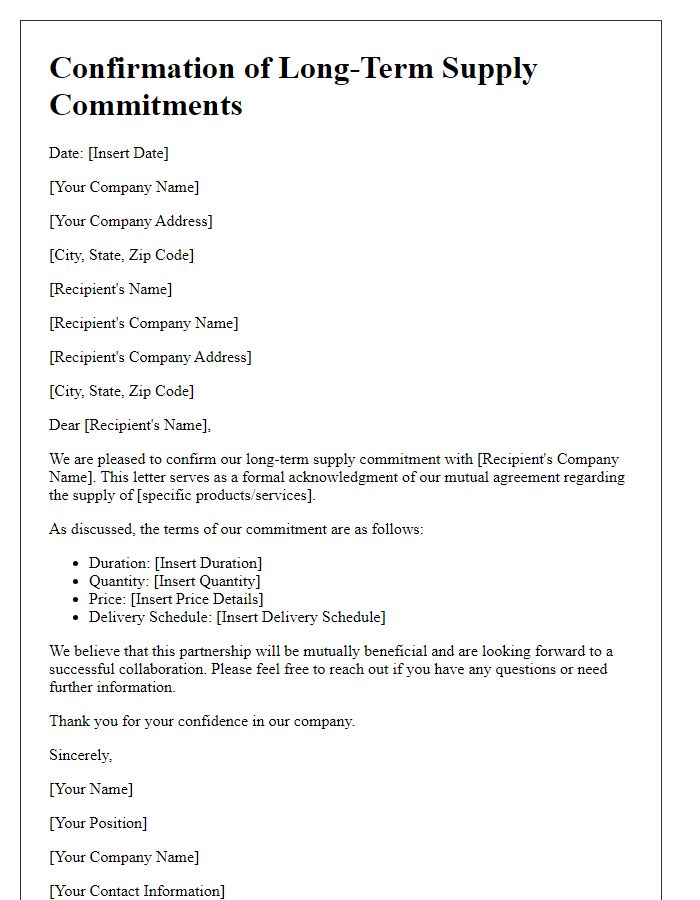When it comes to establishing a long-term contract with a supplier, there are several key factors to consider that can greatly impact your business relationship and overall success. It's essential to think about not only the pricing and quality of products but also the supplier's reliability and service track record. Building a strong partnership can lead to mutual benefits, ensuring that both parties thrive in an ever-changing market. Ready to dive deeper into the nuances of crafting the perfect long-term supplier contract? Let's explore this further!

Contract Duration and Renewal Terms
Long-term contracts can establish stability and reliability in supplier relationships, particularly in manufacturing industries. Typically, these agreements span multiple years, often ranging from three to five years, allowing both parties to plan resources efficiently. Renewal terms should outline conditions for extension, including performance evaluations and market conditions, which can lead to price adjustments or renegotiations. Explicit timelines for notices and potential exit strategies must be included to mitigate risks and ensure continued compatibility. Involving legal counsel can safeguard interests during negotiations, ensuring compliance with regulations and minimizing potential disputes.
Pricing and Payment Terms
Pricing strategies play a crucial role in long-term supplier contracts, influencing the overall cost structure and financial stability of businesses across various industries. Fixed pricing models often provide predictability; nevertheless, dynamic pricing, reflecting market fluctuations, can better align with supply chain realities. Payment terms, such as net 30 or net 60, significantly impact cash flow management, allowing companies to maintain liquidity while honoring commitments to suppliers. Early payment discounts can also incentivize prompt payments, benefiting both parties. Establishing transparent pricing mechanisms, such as unit pricing versus bulk pricing hierarchies, ensures clarity and fosters trust between suppliers and clients, essential for sustaining long-term partnerships.
Quality and Performance Standards
Quality and performance standards significantly influence supplier long-term contracts in various industries. Establishing parameters such as defect rates below 2% and on-time delivery exceeding 95% is essential for maintaining product integrity. Additionally, performance metrics like response time for customer inquiries (ideally under 24 hours) and compliance with regulatory certifications, such as ISO 9001, can determine reliability and performance benchmarks. Frequent assessments (quarterly reviews are common) of supplier capabilities and adherence to agreed standards help ensure continuous improvement. Geographic factors, supplier location (such as sourcing from established regions like Southeast Asia), also affect logistics and risk management, impacting overall supply chain efficiency.
Delivery Schedule and Lead Times
A well-defined delivery schedule is critical for maintaining a smooth supply chain, especially in long-term contracts with suppliers. Specific timelines emphasize the frequency of deliveries, such as weekly, bi-weekly, or monthly intervals, directly impacting inventory management. Lead times, typically ranging from 5 to 30 days depending on product type and supplier location, need careful evaluation to ensure alignment with demand cycles. An accurate delivery timeline can prevent disruptions, facilitating timely project execution. Regular communication regarding changes in delivery schedules, especially during peak seasons or unforeseen circumstances like natural disasters, is necessary to maintain transparency and foster a reliable partnership. Establishing penalties for delays and offering feedback can further strengthen compliance with delivery expectations.
Dispute Resolution and Termination Clauses
A long-term supplier contract should include specific clauses addressing dispute resolution and termination to ensure a stable, mutually beneficial relationship. Dispute resolution mechanisms, such as mediation (a non-binding process) and arbitration (a binding process), can provide structured solutions, offering clearer timelines and potentially avoiding lengthy court proceedings. Exploring alternative dispute resolution centers, such as the American Arbitration Association, can add credibility and efficiency. Termination clauses must specify conditions under which either party may exit the agreement, such as breach of contract, insolvency, or failure to deliver goods on time. Including notice periods, typically between 30 to 90 days, allows both parties to prepare for the transition, while also considering potential damages or liquidated compensation in case of wrongful termination. Furthermore, specifying the governing law, such as the Uniform Commercial Code (UCC), can provide clarity on legal interpretations and obligations.
Letter Template For Supplier Long-Term Contract Considerations Samples
Letter template of inquiry about long-term contract terms with suppliers.

Letter template of negotiation points for extended supplier partnerships.

Letter template of evaluation criteria for supplier long-term contracts.

Letter template of feedback on supplier performance for future contracts.

Letter template of discussion for establishing a long-term supplier relationship.

Letter template of terms of engagement for long-term supplier contracts.








Comments